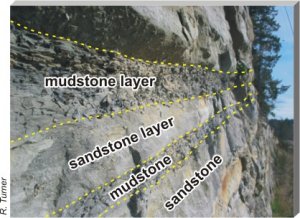Proactive disclosure
Print version   |  | 
Natural Resources Canada > Earth Sciences Sector > Priorities > Geoscape Canada > Nanaimo
Geoscape Nanaimo
Geoscience for central Vancouver Island communities Water from underground

Fractured mudstone layers like these exposed in road cuts near Duke Point are important groundwater aquifers in the region.
|
Underground water, or 'groundwater', is produced by seepage of rainwater, snowmelt, and stream waters into rocks and sediments. Groundwater commonly resides in fractures and holes in bedrock and sediments. Water wells tap into this underground water supply. The quality of groundwater is often good, but it can be damaged by human contaminated water that percolates down from the surface. Some groundwaters are naturally contaminated with elevated levels of iron, hydrogen sulphide, or fluoride.
Groundwater supplies can be depleted by overpumping. The water table drops when more water is pumped from the ground than is replenished. Groundwater can also be contaminated by salt water in coastal areas. A boundary exists between fresh groundwater under land and salty groundwater beneath the Strait of Georgia. Coastal wells near this boundary may pump salty water some of the time. Overpumping increases this problem as saltwater is drawn toward the well.
|
